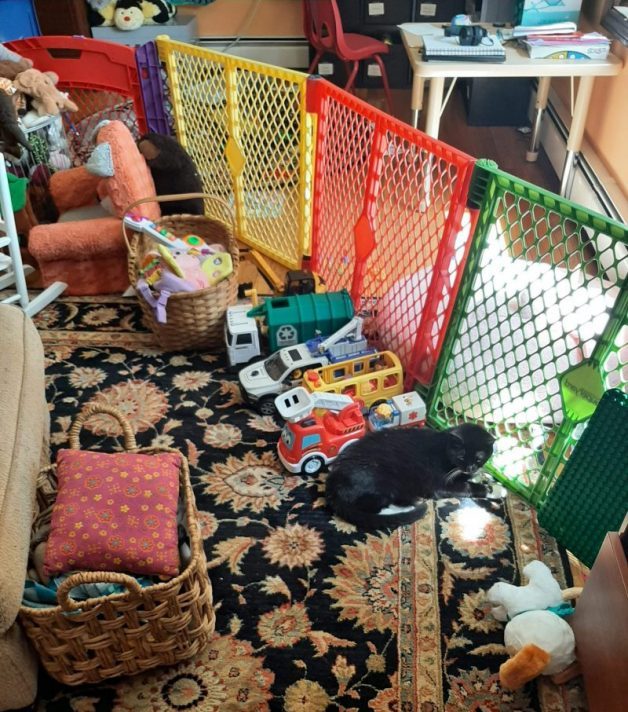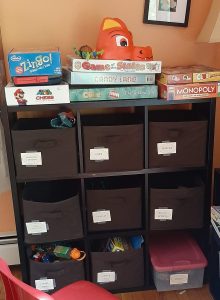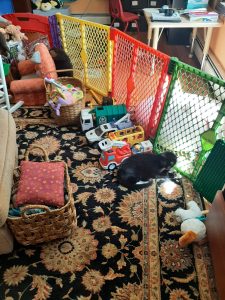Recently I organized my (nearly) 7 year-olds toys. I had some ideas from books I have read recently, including “Organizing from the inside out” by Julie Morgenstern and “Decluttering at the speed of life” by Dana K. White. I recommend both of these books!
Talking to my “client”
From the first book I had the ideas to ask questions to my “client” (my child) about what was and was not working in his space. This is the “analyze” step in the process outlined in the Morgenstern book. This comes before actually diving into the decluttering and organizing. This was helpful because he brought to light some things I hadn’t thought of, but also that meant that I had his buy-in to do the project. We came up with a plan for me to do a little every day and then get his okay for any changes. We also had fun (his idea) drawing a before and after map of the space!
SPACE method
The space where the toys live is a section of the living room. We decided during the analyze phase that one category of activity (and accompanying supplies, i.e. stuff) was going to go to his bedroom instead. That made a big difference! All of the activity books were moved to the bedroom where he has a bin and a desk. Activity books includes things like crossword puzzles and color-by-sticker books.
The space already had cube shelves and cube fabric bins. I also ended up repurposing some other plastic storage bins and moved a toy chest from the bedroom to the living room.
Morgenstern’s book outlines the SPACE method. S stands for sort, P for purge, A for assign a home, C for containerize, and E for equalize. E is for after the project- in a few weeks check in with the space, make sure everything is going well, and then try to maintain it.
Based on going through the sort part of the SPACE method, I ended up with the following categories of toys, most of which went into the fabric bins:
- Living things (animals and figurines)
- Dinosaurs and dragons
- Cups
- Blocks
- Crafting kits
- Card games
- Balls and sports
- Stuffed animals (went into and sitting atop toy chest)
- Legos
- Prizes / small toys
Containerize
I created fairly simple labels in microsoft word, printed them up, and taped them to the containers. I don’t think the tape will last very long, so my plan is to use a hot glue gun soon.
My son has given me a ringing endorsement! It is helping him to find the exact toys he wants, which was one of our goals for the space.
I was pleasantly surprised it didn’t take as long as I thought it would. I also got a kick out of the “prizes” category. Sometimes it seems that the most beloved toys are the tiny items from birthday party goody bags and the school store. So they deserved their own home! I was trying to respect my client and the things that he treasures.
Bins with labels and board games on top
P is for “purge”
A big part of organizing is decluttering. This is where the suggestions from Dana K. White’s book were extremely helpful. Her method makes it possible to declutter in small pockets of time and not make an even bigger mess.
What is decluttering?
“Decluttering is about identifying the stuff you really want to keep, in a way that you can handle” – Dana K. White “Decluttering at the speed of life” p. 211.
I have too much stuff in my home. Decluttering is getting rid of excess stuff – either throwing it out, recycling it, or giving it away. If I had less stuff it would be easier to use the stuff that I like and is helpful. In the case of my sons’ toys, if he had a neater space, without broken toys in the way, he could have an easier time doing an activity he loves, like legos or board games.
Dana’s decluttering steps
She recommends you look at a space, such as a single shelf, and just declutter it, don’t try to organize it. Her recommended steps:
Step 1 – remove trash
Step 2 – remove easy stuff – items that you know belong somewhere else, that have an established “home” in your home
Step 3 – the “duhs” (stuff you hate and can part with)
Step 4 – asking the two decluttering questions: 1) if I needed this item, where would I look for it? 2) if I needed this item would I remember I have it?
Step 5 – everything that is left should fit into the space easily. If not, keep decluttering.
What is KEY to this method is that you move the stuff right away. For example, in step 2, pause and take the item to its home. If you don’t do this, you might get interrupted and then you have made an even bigger mess than when you started.
Decluttering with a timer
I used this method when I was sorting through my child’s toys. I set a timer for ten minutes (I live by timers) and went through the steps. When the timer beeped, I would move stuff from step 2 and step 4 into its home. This became clearer as I moved along. For example, if I had already made a tentative decision that bin 1 would be for balls and bin 2 would be for dinosaurs, when I came across a stray dinosaur, I would put it into its home when the timer ran out. Before I put my official labels on the bins, I used sticky notes. I also showed the tentative categories to my “client” when he came home from camp and got his okay.
Dana’s method was great because it meant I could stop when I wanted to stop and not have a big messy pile out in the open.
Bonus picture – which item doesn’t belong in the trucks category?




Kitty!
This was very enlightening.